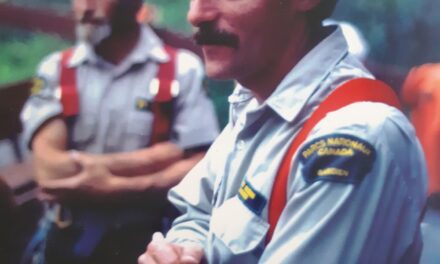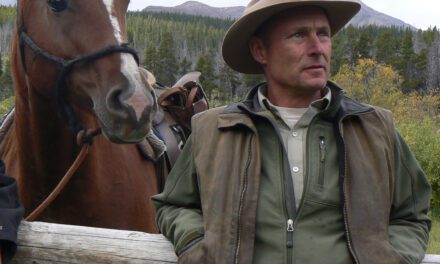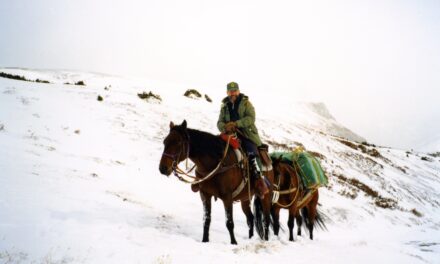(1:13:58) I rode saddle broncs, bare backs and bulls. Then I finally smartened up. The first time out of the chute in 1939, I was a boy steer riding and the last FCA rodeo they had in Banff, I think that was in 1962. I was on a bareback horse.
(1:14:53) I’ve got one (photo) taken up at the Ya-Ha Tinda. It wasn’t a government horse. In 1955, I rode up from Caroline to the Ya-Ha Tinda. He bucked every day. He bucked me off every morning. I rode up him up to Clarence’s ranch, three miles, and gathered the stallion, mare and colt. They belonged to old Clarence Long’s trap line and brought them back. The guy that owned this horse was scared of him. I was the first one who ever stepped on him. He wasn’t broke, but the ground work was done on him. But, he bucked me off every day. I got back and this guy was going to ride or buy him, but then he wouldn’t even get on him. He was scared of him… So this Joe Bardgett this stock contractor, he bought him. He was a four year old that was in 1955. He was killed coming home from the National Finals Rodeo in a liner wreck when he was 21 years old. I’m the only person who can truthfully say I rode him. I rode him for two days up, one day there and two days back. Five days, long days…Everybody else was on him eight to ten seconds. I rode him for five days. They called him the Painted Saint. He was a three colored buck skinned pinto. He finally went to the pro rodeo circuit. Harry Vold bought him. He was killed in a liner wreck coming home from the National Rodeo in Oklahoma. That was my saddle horse.
(1:16:52) I took three months off when I was working trail crew for the warden service. March, April until May orJune then I went back in the middle of June as a heavy equipment operator, building that fire road up the Alexandar River…I was peeling fence posts in Banff by hand and stuff like that and I didn’t want to do that!
Part Two (0:00:02) Jack Woledge and his dog team went on a winter patrol with me up Stoney Creek, down the Dormer River, across to the Ya-Ha Tinda. The first day up, the snow was not too bad until we left Stoney and started up over the Dormer shortcut. The top of the pass is 8100 feet. Well above timber line. It took us six and a half hours to go about three miles. Tough going…Jack would go ahead. He’d leave the dog team (behind). I would go with him, snowshoe for maybe a hundred yards. Then he’d come back and I would go ahead, because I couldn’t drive the dogs. Two of his dogs as soon as they would hear my voice they would turn and look back to wherever I was, so I’d go ahead. I was in snow to here (pointing to his waist) and the dogs were sinking right to their bellies. That was five trips with snowshoes! The snow would just not pack. We got to this one place and there was a bowl. The trail was only about a foot wide. This slide had come down and it was hard. It took me an hour and a half to clear that trail across there wide enough with my snowshoe heel to get the toboggan and the dogs across. Then we started on the summit. It was cloudy. We started down because you can’t stay on the trail, you got to go right down the creek in the winter time or you would bring an avalanche down on yourself. I was sitting on the toboggan and Jack was on the back. We’d feel the wind in our faces. But the lead dog, he kept trying to swing up to the right, out of the creek. The wind blew the clouds away and the moon came out a little bit. He (the dog) wheeled out right in front of me and he was sitting down. We were on the top of the avalanche! That’s why the dog wanted to get out, he was sliding down to the creek bottom! It‘s about a mile and a half down to the bottom. We were at the top end of this avalanche. That’s why this lead dog was trying to pull us out! She was on this snow slide, avalanche. We could have got hurt because we were on the very top. We were just moving slow, but enough that we could feel the wind in our face. We thought we were moving pretty good down there. Then the clouds moved away and the moon came out and we weren’t going no place! The dogs weren’t travelling, they were sitting down. Except the lead dog, she was trying to get out of there and go up the side bank.
(00:03:33) We used skis some, but with the dog team we used snowshoes. I didn’t use skis when I was by myself, because I wasn’t as good of a skier. I’d skied a lot as a kid, but we just a strap across the ski there was nothing to tie your foot down or nothing.
(00:04:04) I went to every one that they had (warden school). Well you learned some things, depending on who you got for an instructor. They had one in the spring, a general school. One in the fall, it was a climbing school and then one in January or February and it was a ski school. You went every year, all the wardens went. Well, the odd one in Banff didn’t go like old Ernie Stenton. He would be at the spring school because he would be an instructor on something. Well in general (everybody went). Ernie Young, he was fire pumps and horse use. We got in trouble one year. I teamed up with Ernie and we showed them how to tandem pack lumber on two horses. Oh, did we ever catch hell on that! “You’re not supposed to do that, because the lumber was short. We could take 16 foot stuff. We take could take the 16 foot stuff with two horses. You had to have three pack horses if you cut it shorter. You couldn’t go around switchbacks, but you picked where you were going with it. I learned a lot of it from some of the outfitters and stuff like that…
(00:06:15) Dad had a picture, he wasn’t involved in it, but he found this picture at the mine office in Brule. They had a mile or two miles, I can’t remember for sure, but one inch cable they were packing up. They packed it from Brule, 20 miles to the Wildhay. They were going into a mine up there that they were going to develop. They had a coil with this one inch steel cable one on this side of the horse and one on the other side of the horse and then back to the next horse. About 29 horses all tied together with this cable! I don’t know where that picture got to, we lost it somewhere.
(00:07:16) Up the Wildhay above Rock Lake there is an old steam engine. They were hauling it in on sleighs in the wintertime for this mine. They broke through the ice and they couldn’t get it out. The outfit closed down, they didn’t finish it (the mine). Quite a few years later, my uncle was in there and somebody asked him, “How did they get that steamer up here?” There are no roads anywhere.“ He said “They brought in a team of sleighs. They said “How come they left it here?” He said, “It broke through the ice.” That old steamer is still sitting up there in the gravel flats. Sometimes its buried, sometimes its open. Gravel washing around it.
(00:08:27) I helped Gerry Lyster figure out how to pack a chesterfield from Lake Louise in to the Cyclone cabin at the head of the Red. I showed him how. Poles across and down each side of the horses, set the chesterfield on the poles and tie it down…Tie the pack horse so he can’t buck his head down. Put a rope across the poles so he can’t duck his head underneath. Tie the lead shank to the pole and its tied on the one side. It’s tied to the horse with the poles off the pack horse so there is something between them. Simple, if you know what you are doing. You got to pick your horses…



